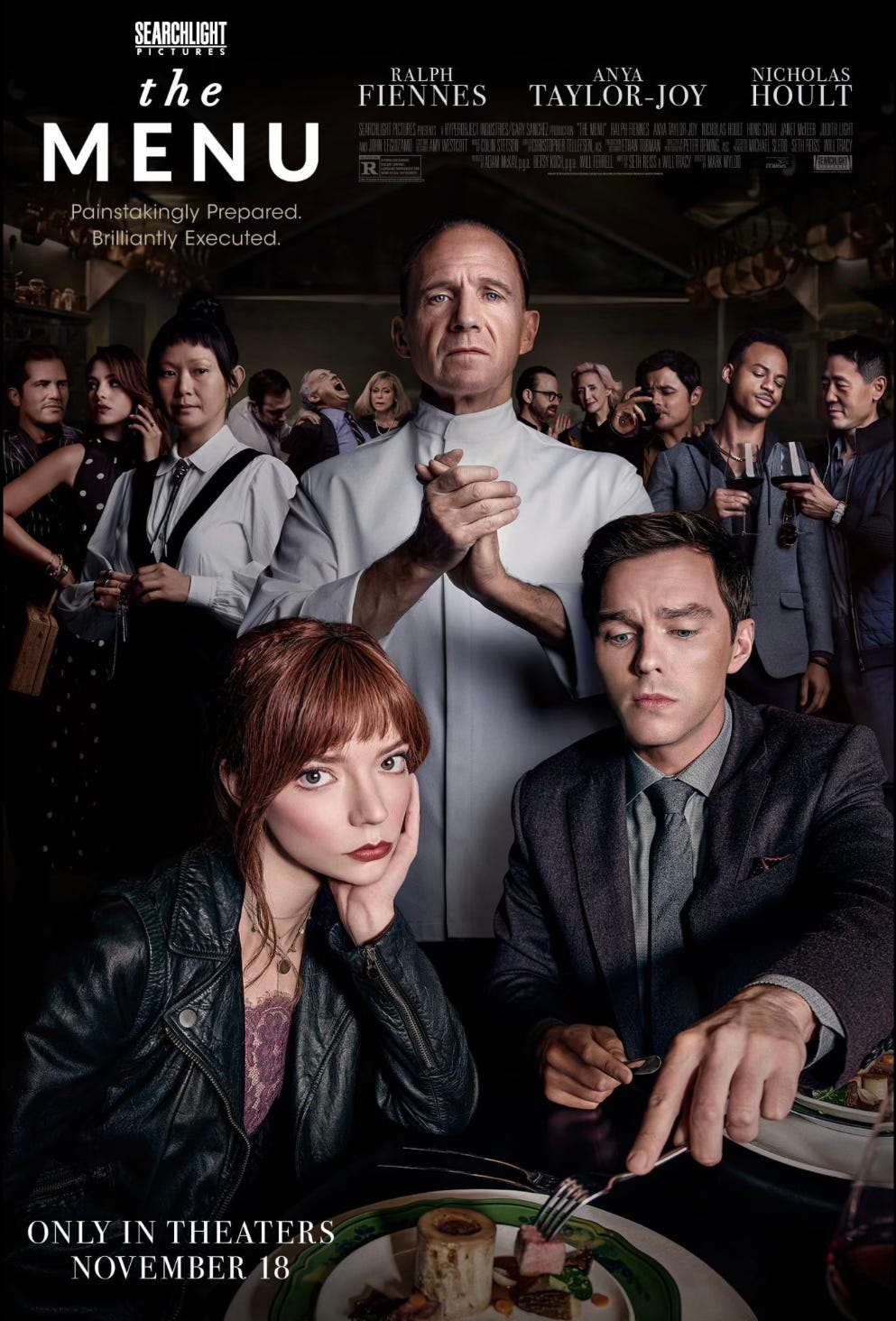I love it when Netflix serves up a movie I never heard of and it’s actually good.
The Menu provided that experience. I completely missed it when it came out in 2022, and it’s not the sort of movie that would have registered as must-see for me anyway.
Directed by Mark Mylod, The Menu is like the horror version of The Bear. The central figure is an elite master chef who crafts unique dining experiences for the most exclusive clientele. Chef Julian Slowik (Ralph Fiennes) lives on a remote island that’s entirely devoted to his restaurant, Hawthorne. His chefs live together on the same island and are entirely devoted to him.
As the movie begins, people board a boat to go to dinner. Among these obviously wealthy fine diners is a young couple, Margot (Anya Taylor-Joy) and Tyler (Nicholas Hoult), but the nature of their relationship isn’t clear. We quickly learn that Tyler is a foodie—an ostentatious one at that—and he’s also a Chef Slowik fanboy. Margot seems far less enthused, and an early scene reveals that she wasn’t Tyler’s original date.
Screenwriters Seth Reiss and Will Tracy dole out the exposition carefully, providing enough information to create a solid setting, establish the various characters, and raise some questions, but otherwise letting everything and everyone play out organically.
Most of the action takes place in the restaurant, making this the cinematic equivalent of a bottle episode. The constricted setting bolsters the tension as the evening’s menu escalates from bizarre performance art to legitimate danger. Some diners can’t tell the difference at first.
The setting also helps limit the cast, allowing each of the diners to become a distinct character rather than just background. Their ranks include John Leguizamo as a popular movie star and Janet McTeer as an important food critic. The restaurant’s staff, however, blends into an almost faceless mass, often speaking in unison. Their devotion to Slowik has utterly subsumed their natural identities, and even the chefs who get the most lines and screentime are all clearly acting under strict orders—orders they seem perfectly willing to follow.
Slowik has planned out every last detail of the evening, including the guest list. But Margot’s presence throws him off. She doesn’t belong, and she wants out. The master chef has no intention of letting anyone leave, however.
Dark comedy adds some flair while social commentary adds some substance. The script plays on the dynamics of servers vs. the served, the working class vs. the elite, and artists vs. consumers. It’s not subtle, but it never gets too heavy-handed either.
Slowik is a culinary artist, one who’s obsessively honed his skills to such an exceptional degree that he’s also whittled his clientele base down to only the wealthiest. And that’s taken a toll on him, which is now coming to a head.
Aspects of the film require ample suspension of disbelief. The movie asks us to accept that all of these chefs just go along with Slowik’s plan, that they have no lives outside of this restaurant and are okay with this. Kind of makes you wonder what he’s done to these people. By not going overboard with the exposition, the script implies an interesting backstory, but it’s best left to the imagination. That restraint serves the movie well.
The movie also restrains the horror. There’s a fair amount of blood, but this is no slasher flick. Psychological horror simmers and builds throughout the film, and that’s far more interesting, especially in the hands of a strong cast devoid of any weak links. Fiennes and Taylor-Joy are the sorts of actors who enhance any project they work on. Another standout is Hong Chau, who represents the creepy, cult-like staff.
The ending gets a bit weird. I like the idea, but I’m on the fence about the execution.
I won’t spoil it, though. It’s best to go into this movie knowing only the basics. The Menu offers something fresh and original that stands on its own—no need to start a franchise. It has something it wants to say but wisely prioritizes rich tension, an unsettling atmosphere, and strong entertainment value.
Not my usual fare, but a welcome palate cleanser.



"Not my usual fare, but a welcome palate cleanser." - I see what you did there! 😆
Unfortunately, not on Netflix here in Canada 😢, but I'll have to check it out if I can!
"Not my usual fare, but a welcome palate cleanser" is a good way to describe it.
I liked how each course had its own "presentation" to the audience, but I wasn't sure if it was also trying for anything more significant with that structuring. Did you have any thoughts on the individual dishes?